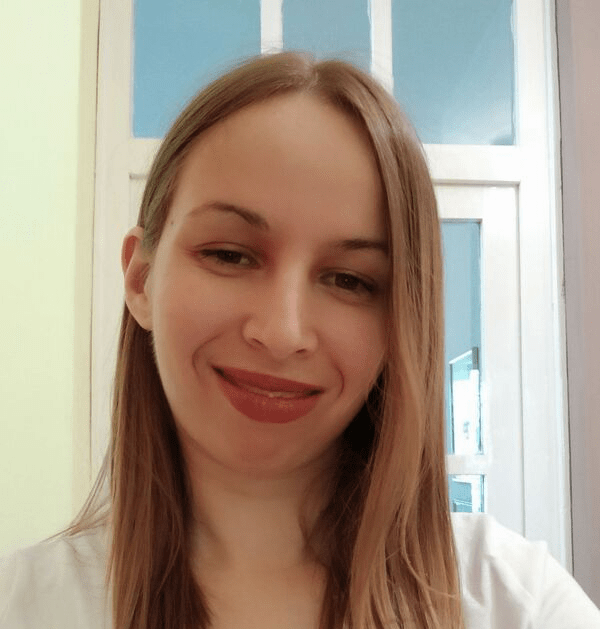Staying focused at work can be as much of a hassle as keeping your focus while working from home — you’ll likely have to deal with many distractions. Sometimes it’s noisy neighbors, other times, constant meetings take away from the time you should be spending on priority tasks.
Still, learning how to reduce common workplace distractions and tweaking your work (and life) habits can help you retain focus and keep moving forward.
To help you out with that, in this blog post, we’ll:
- Talk about why you struggle to focus at work,
- Give you 20 effective tips that will help you improve your concentration,
- Explain the main benefits of staying focused, and
- Provide you with some handy instant focusing techniques.
So, let’s begin.
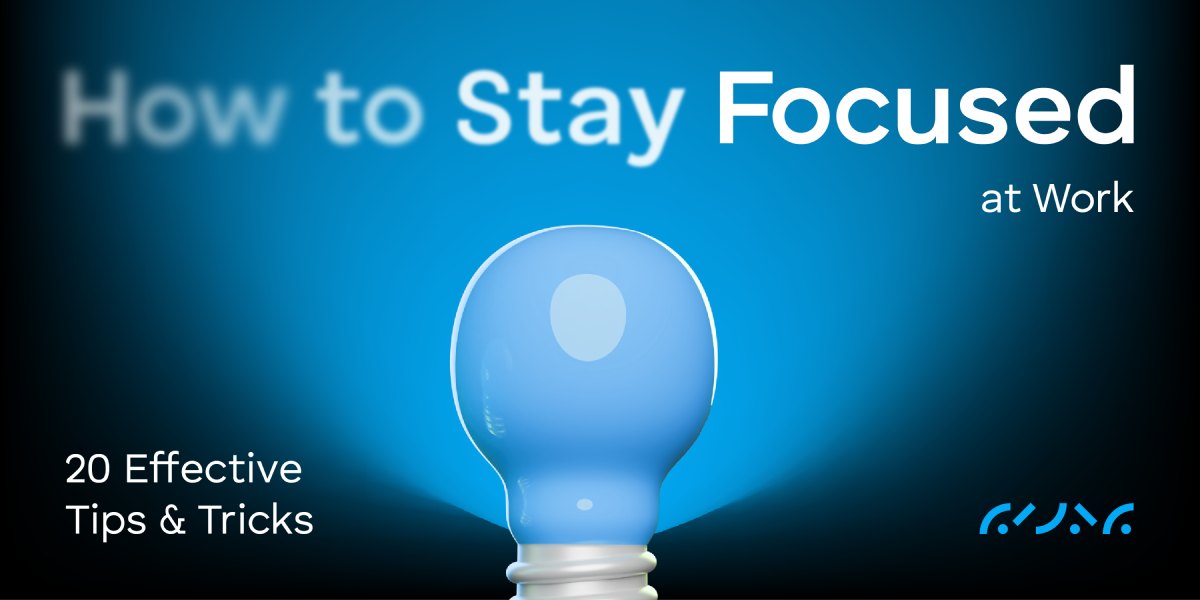
Table of Contents
Why do I struggle to focus at work?
Distractions are everywhere — whether you work in an actual office or you’re comfortably seated in your home chair. However, external distractions are not the only reason you can’t focus on work.
Perhaps you waste your time on trivial things and burn your brainpower and energy by having an internal debate over what to eat or wear.
Or, you might lead an unhealthy lifestyle and struggle with sleep deprivation which leads you to make more mistakes.
Some people even struggle to leave their personal issues out of work, making it difficult to manage their emotions and achieve the optimal level of focus for completing their tasks.
So, before deciding on a technique for improving your focus, try to:
- Take a long hard look at your habits,
- Identify which of these concentration killers are the main culprits for your attention deficit, and
- Build your way up from there.
This way you’ll be able to introduce far-reaching changes to your lifestyle and develop lifelong habits that will help you retain focus despite the circumstances.
Now that we’ve established why you can’t concentrate at work, we’ll provide you with some useful, practical advice on how to improve concentration.
20 Tips on how to stay focused at work
As we’ve promised, here are 20 tips that will show you how to increase focus by altering your work or lifestyle habits, inducing new scheduling methods, avoiding distractions, and much more.
So, let’s get right to it.
Tip #1: (Re-)evaluate your work habits
Before you start blaming others for distracting you and thus making you less productive, think about your work habits and whether they make you productive in the first place:
- Do you force yourself to get up early in the morning just because that’s what productivity gurus recommend, only to spend the hours before noon drowsy, moody, and unfocused?
- Do you wake up fully energized, only to immediately focus on frivolous tasks that drain your energy until you have no zest left to finish the project that’s due tomorrow?
- Do you work for 2 hours in the morning and then go to an early lunch just when you’ve fully immersed yourself in work because you want to adjust to your colleagues’ schedules?
If your answers are a sad “yes,” then it’s your own work habits that you need to re-evaluate and change.
How best to (re-)evaluate your work habits
A problem with your work habits has a lot to do with how you schedule your day. You may schedule activities too early or too late in relation to your biological prime time, i.e., the time when you’re the most productive:
- If you’re the most productive later in the afternoon (and you have flexible work hours), try to get to work at a later time — you’ll avoid the dreaded morning drowsiness and ensure a larger number of productive working hours per day.
- If you’re the most effective early in the morning, schedule your most important activities for this time — you’ll finish your priority tasks early, and spend the rest of the day working on less urgent activities, thus relieving yourself of unnecessary stress.
- If your colleagues have different productivity peak hours than you, don’t try to fit in with them no matter what — do your work at your own pace and try to socialize with colleagues at other times.
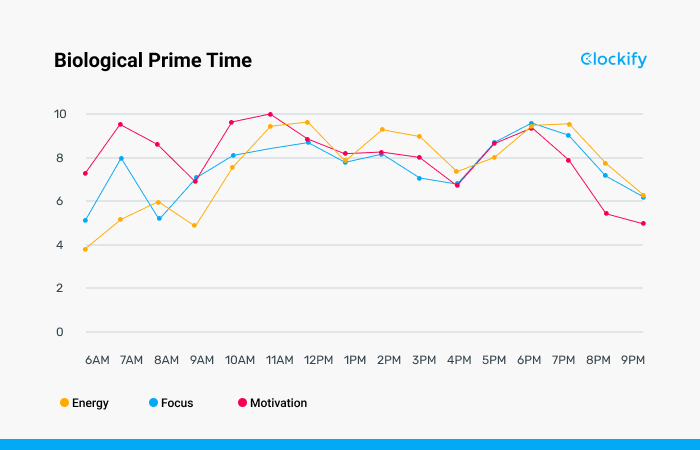
Following a fixed routine is beneficial for productivity, but, you’ll have no benefit from it if it’s the wrong fixed routine. So, work on your current schedules to find ideal times for all your assignments.
To calculate your biological prime time, you can use a time tracker like Clockify and track the time you spend on the same activities in the morning and the afternoon. That way, you’ll see when you’re more efficient with said activities.

You can do this for all your work activities to create an archive telling you when you’re the most efficient with a certain type of task.
💡 Clockify Pro Tip
If you already know whether you are more productive earlier or later in the day, check out the following guides:
Tip #2: Create and follow a to-do list
Not organizing or prioritizing your work can interfere with your ability to concentrate, so it’s best to sort your tasks and make a to-do list.
Therefore, the first thing you need to do to start your day right is to create a to-do list you’ll follow. This way, you’ll know:
- Exactly what you need to do today, and
- Which tasks you’ll need to reserve time on your calendar for.
💡 Clockify Pro Tip
If you want to see the main differences between some of the interesting methods you can use to organize your to-do list, read our blog post:
How best to create and follow a to-do list
Customize your own to-do lists to your liking — for this purpose, you can use one of our free to-do list templates. Whether for work, school, or even daily chores — create and download your personalized to-do list in PDF format, share it with your colleague in Google Docs, or simply print it out.
When creating your to-do list, make sure you:
- List all the tasks you need to do today,
- Parse these tasks into smaller subtasks you can keep track of more easily,
- Mark all items as urgent/NOT urgent and important/NOT important,
- Reshuffle your list to put tasks and subtasks you marked as urgent/important first,
- Delegate the tasks and subtasks you’ve marked as urgent/NOT important — delete them from your to-do list, notify the person you’re delegating to, and
- Eliminate tasks you’ve marked as NOT urgent/NOT important — delete them from your to-do list.
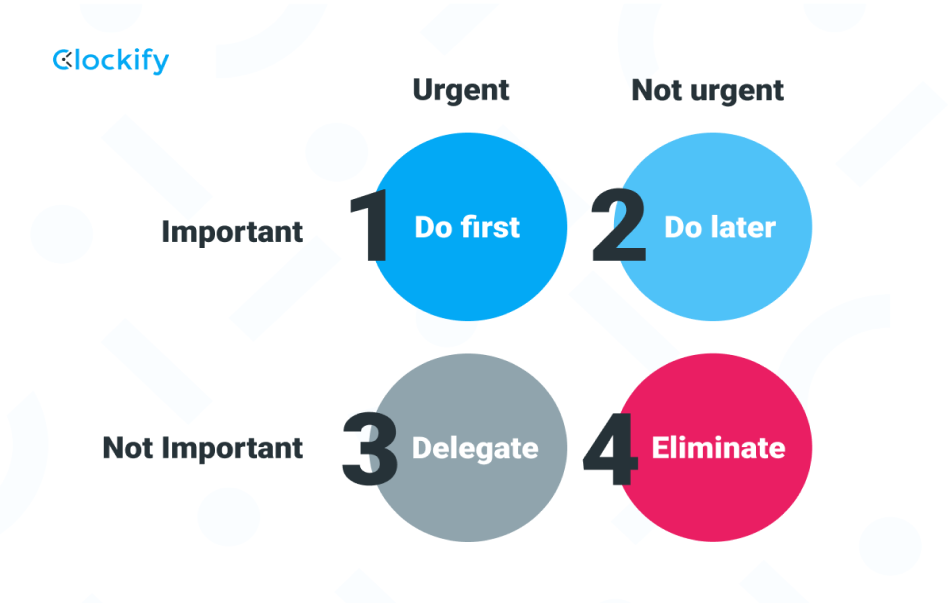
💡 Clockify Pro Tip
Read more about the Eisenhower matrix and how to use it to make efficient to-do lists here:
It’s of the utmost importance to prioritize your work when creating to-do lists. Therefore, when you start working, do your urgent/important tasks and subtasks first, and your NOT urgent/important tasks and subtasks second.
Then, put a checkmark next to each task you finish, as soon as you finish it. Watching the number of tasks you’ve finished increase will make you feel more confident to continue working and reach the end of the list as soon as possible.
To facilitate the creation of a to-do list, you can use task management software like Plaky and have all your tasks sorted and in one place.

💡 Clockify Pro Tip
To learn more about the importance of prioritizing your workload and how to actually do it, check out this article:
Tip #3: Timebox your emails and meetings
On average, you spend about 13 hours per week on emails and about 6 hours on meetings. That means you spend almost half of your workweek on routine activities that don’t bring your company any profit.
To minimize the time you spend on these less important activities, you can limit meetings and inbox management tasks by timeboxing your schedule.
With timeboxing, you’ll plan your day more efficiently by allocating less time to activities that are not your priorities.

How best to timebox emails
For example, you can schedule 15 minutes for managing your inbox every 2–3 hours. Start the timer, and once the 15 minutes are up, close your inbox, even if you’re in the middle of writing an email.
After 2–3 hours, it will be time for another email timebox. You’ll then have 15 minutes to continue writing the said email.
How best to timebox meetings
The same goes for meetings. If you have a standup meeting every day, set aside 20 minutes for it each day, and try to wrap up the meeting as soon as the 20 minutes are up.
This way, you’ll ensure you stick to your meeting agenda and keep everyone focused on what they want to say in a straightforward and fast manner.
By timeboxing your meetings, you’ll put the time you spend on them under control and save more time and concentration to allocate to more important tasks.
In case you’re not the one who organizes the meeting and decides how long it’ll last, you can maintain your focus by automating repetitive tasks, which will leave you enough time to finish all the tasks that require your undivided attention.
💡 Clockify Pro Tip
If you’re interested in learning how to organize your tasks and your time for maximum efficiency, check out this blog post:
Tip #4: Define personal deadlines
Setting personal deadlines and parsing your project into milestones helps you work your way through projects briskly. A personal deadline can be any time frame you come up with that comes before your official deadline.
Even though official deadlines set by your supervisor or clients still remain your main frame of reference, personal deadlines are there to increase your chances of completing your tasks on time.
How best to define personal deadlines
So, once you are assigned your share of work on a project, block time in your calendar for your tasks and set a realistic deadline. Here’s what you should keep in mind when defining your personal deadline:
- Don’t set a loose deadline — according to Parkinson’s Law, all your tasks expand to fill the time you’ve allocated to them, so try not to give yourself more time than you need.
- Don’t be overly optimistic about your deadline either — Hofstadter’s Law states that your tasks usually take more time than you originally think, so try to be as realistic as possible when setting a deadline.
The best practice is to set your deadline based on previous experience with the same type of tasks. If you know it takes you 3 hours on average to finish a project proposal, then you should set a deadline of 3 hours each time you write a project proposal.
Sure, sometimes it will take you 5–10 minutes more, sometimes 5–10 minutes less, depending on the scope of the proposal. However, following the steps for defining personal deadlines will help you obtain the most precise time estimate faster than ever before.
Tip #5: Make others aware of your schedule
Once you’ve organized your work, defined your deadlines, and identified your priorities, it’s best to make sure your colleagues are aware of your schedule.
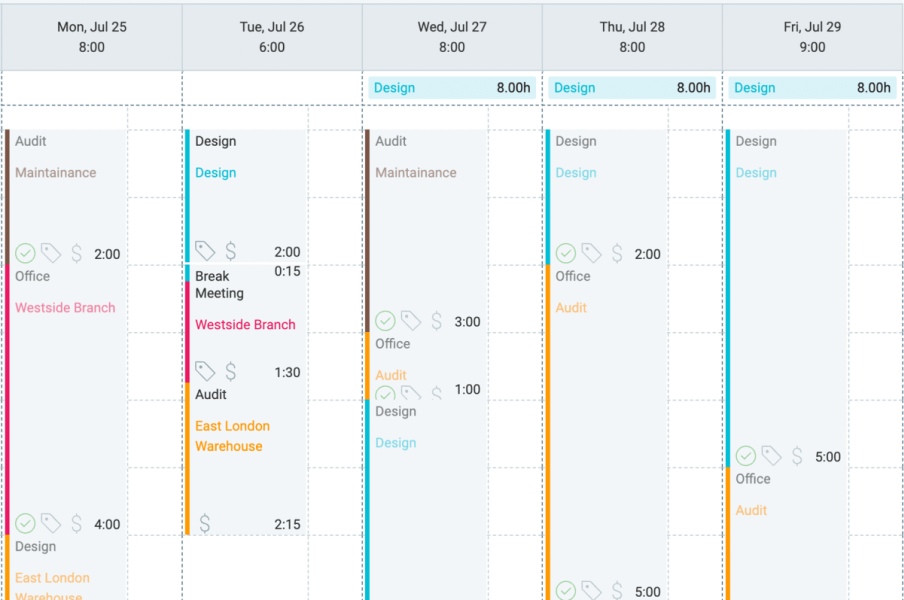
How best to make others aware of your schedule
For this purpose, you can take a popular time management game called “Circadian Rhythms” as inspiration and make your schedule public. To play this game, you and your colleagues need to write plans with your daily activities and your energy levels throughout the day and post those plans on a wall. This way, everyone gets to see when is the right time to call their co-workers and for what type of task.
Aside from posting plans on a wall, to make your co-workers aware of your schedule, you can:
- Hang a printed version of your schedule for the day/week on the front of your office door, or
- Share your Google Calendar with your colleagues.
As an alternative, you and your colleagues can join the same workspace to track time in a team Dashboard. This way, you’ll all be able to see what everyone is currently working on and decide whether it’s the right time to interrupt them.
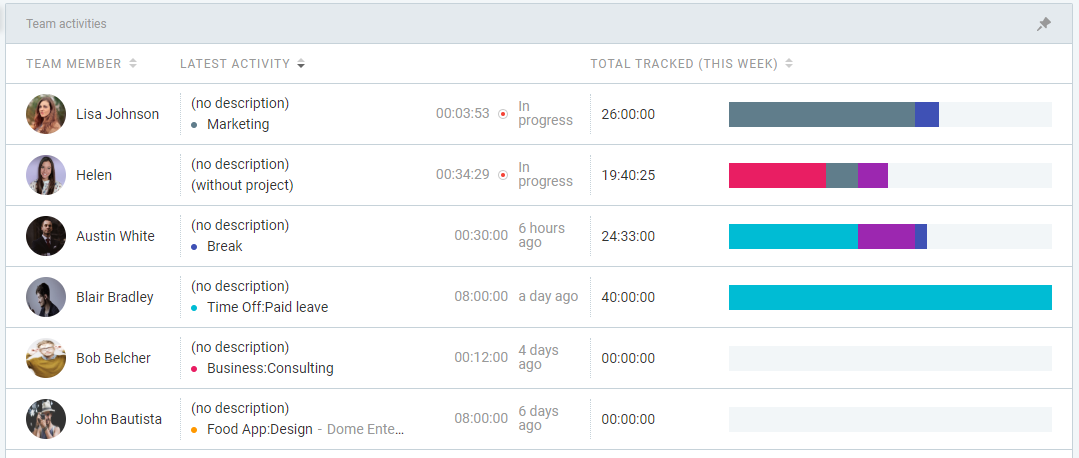
Tip #6: Take short breaks
According to research on the effectiveness of short breaks for improving well-being and performance, breaks are among the most important things that not only help you focus but also reduce your mental fatigue levels. They function as controlled distractions from our work, vastly improving our ability to concentrate and thus perform better at work.
So, taking regular breaks is important for maintaining focus for longer periods of time — you’ll recharge your energy and increase your alertness levels.
How best to take short breaks
As the previously mentioned research explains, taking a respite from working on tasks helps us be more productive and stay energized and concentrated throughout our workday.
So, to make sure to take frequent breaks, take a look at the list of ideas on what to do when you step away from your desk:
- Go outside to take a walk around the block — the fresh air and natural sunlight will help increase your productivity and even help you improve your sleep quality.
- Make yourself a cup of green tea — this type of tea is a superfood filled with antioxidants, minerals, and caffeine, perfect to increase your physical performance.
- Do some desk stretches — you’ll feel refreshed.
- Watch an educational TED video — you’ll distract your mind from a current problem for 5 minutes and learn something new, like how sugar affects your brain and why we dream.
- Chat with a colleague you rarely see by the water cooler or reach out to them via the team chat app — you’ll get a social boost and refresh your mind.
What’s more, you can make use of the Pomodoro timer that can help you track the time you spend on tasks while keeping you focused and improving your productivity altogether.
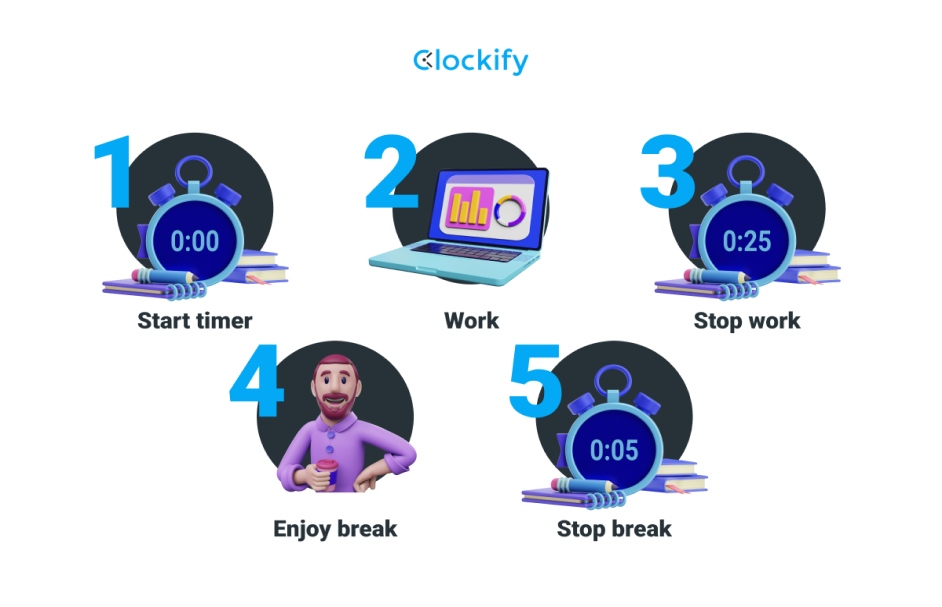
The Pomodoro technique works on a very simple yet effective principle. You work in 25-minute “pomodoro” intervals separated by short 5-minute breaks. Every five “pomodoros,” take a 20 or 30-minute break.
Afterward, it will be easier to start another focused work session. Plus, now you’ll know you have something to look forward to when you start feeling too hazy to continue work.
Tip #7: Turn off notifications in apps
Notifications in apps are useful in general. They tell you when you can update a favorite program with new useful features or when your colleague has just sent you a new message.
But, when you’re trying to focus, a message from your colleague telling you about the newest Black Friday deals would only distract you.
How best to turn off notifications in apps
You can disable notifications on all your devices altogether or disable notifications just for a select number of apps.
Most apps have the option to disable notifications, so you can do that app by app. For example, you can select the channels you want to get notifications from in the settings of your chat app or block updates from a certain program you’re looking to uninstall anyway.
💡 Clockify Pro Tip
Learn about the importance of decluttering your digital workspace here:
Also, you can use ‘Do Not Disturb’ mode for your emails.
According to Juliet Dreamhunter, a certified goal success coach and productivity consultant, utilizing ‘Do Not Disturb’ mode for emails is one of the best ways to take control over your focus:

“Emails can be really disruptive to your work and prevent you from getting important tasks done. Set designated times to check your inbox and turn off email notifications so they don’t constantly pull your attention away from focused work.”
💡 Clockify Pro Tip
Have you ever thought about the amount of time you spend checking your inbox? To learn how to manage your emails more productively, check out what a professional organizer, Patty Kreamer, says on the subject:
Tip #8: Schedule quiet time
Finding some quiet time when you have to finish an important assignment with flying colors is often challenging.
So, it’s best to find a quiet, isolated place where you can go to work when you need ultimate focus and zero distractions.
How best to schedule quiet time
If you work from home and get distracted by noisy household members, try setting some ground rules. You can all sit down together and make a schedule, or some sort of compromise, that fits everyone’s needs. If you need quiet time for an important video call or a task that needs to be completed by tomorrow, that can be an ideal opportunity for them to finish some of their errands outside the house.
In other cases, like when you work on-site, you may have to leave your desk and move to some other, distraction-free room to work.
Nowadays, most companies that operate on-site have an open office policy — you all sit and work together, for better or for worse.
But, most offices still have isolated rooms for meetings and similar activities.
So, when you’re feeling overwhelmed but have an important project proposal to finish:
- “Book” the conference room for an hour or two when there are no meetings and job interviews planned.
- Explain to your colleagues that you don’t want to be disturbed during this time.
- Take your laptop, put on your headphones (if you want a fully immersive effect), and focus all your attention on the task at hand.
As a result, you’ll likely work faster and achieve better-quality results. You’ll probably also feel a nice tingle of accomplishment once you re-emerge in the open office with a perfect final product.
Tip #9: Avoid your phone
Your phone is often your biggest obstacle on the road to focus at work. You can use it for phone calls, texting, browsing the Web, posting pics on Instagram, and more. In other words, you might use your phone to waste the time you should be allocating to work.
So, if you’re wondering how to increase focus and attention, avoid your phone like the plague during work hours.
How best to avoid your phone
It’s best to keep your phone on mute at work. This way, you won’t get distracted by notifications about personal emails, texts, phone calls, and news articles delivered directly to your inbox at an alarming (and annoying) rate.
Unfortunately, putting your phone on mute will only get you so far.
You can always reach for it in your pocket and see all these new, shiny notifications any time you want. So, you’ll likely need to take more drastic measures to deal with your lack of self-discipline at work.
Your best solution is to leave your phone or other devices that you use for cyberloafing at a place you can’t always reach. Cyberloafing happens when you use the Internet for personal use (e.g. surfing the Web, using social media, etc.) during office hours. To prevent that, leave distracting devices at some of these places:
- A locked desk drawer,
- A hard-to-reach place in your bag,
- A cabinet in the office kitchen, or
- The glove department of your car parked 8 stories below and half a mile away.
The more attached to your phone you are, the further away you should leave your phone during work time — this way, you won’t fall into temptation as often. And, if you do, you’ll at least get some fresh air and exercise looking for your car in the parking lot.
Tip #10: Avoid time-consuming websites
Working on the computer for 8 hours per day also makes it relatively easy to slack off on the computer. You can watch random YouTube videos, scroll your Instagram feed, and aimlessly browse the web.
Such procrastination habits can easily lead you to fall out of line with your schedule and work extra hours to make up for the lost time.
How best to avoid time-consuming websites
Avoiding fun websites such as YouTube is much easier said than done, so once again, it’s best to turn to an external app to help you block time-consuming websites.
Website blockers such as Cold Turkey or Freedom are a good choice — they let you add the URLs of the websites you want to avoid to a blacklist. Consequently, you won’t be able to access them during preset times or until you whitelist them.
In case you want to have detailed reports on how you spend time throughout your workday, you can automatically track your computer activity to better manage your time.

This way, you’ll have a better grasp of how much time you spend on productive work and how much on distractions such as social media, emailing, and similar. Comparing these times will definitely beat the habit of cyberloafing and improve your focus once and for all.
Tip #11: Use specialized headphones
Your focus is also often challenged by the noise from your surroundings — whether you have to deal with noisy neighbors and household members or work in an office full of people where there’s always something going on.
In case you’re, for some reason, unable to move from the noise and relocate to an empty conference room or similar, specialized headphones are a great solution. They’ll help you block the noise and give you some peace at work.
How best to use specialized headphones
Investing in a pair of noise-canceling headphones is a great idea — whether you work from home or in an open space office, they will enable you to concentrate better by dampening the disruptive noises around you.
They’re also useful because they almost completely erase lower-frequency sound waves — the same sound waves that make you tired if you’re exposed to them for too long.
However, the only downside to noise-canceling headphones is that they often come with a hefty price tag. But you can usually find some affordable solutions or borrow a pair from a tech-savvy friend.
Or, you can make a request letter for these headphones at the office and see whether it gets approved.
Tip #12: Use productivity tools and extensions
Sometimes, you just need a little extra help with staying fully focused on your work. Luckily, the ever-evolving world of technology offers a lot of hands-on tools and extensions for that purpose.
The previously mentioned website blockers and time trackers are just the tip of the iceberg — there are various tools that can help you plan your workday and execute work with focus.
How best to use productivity tools and extensions
For maximum output, use productivity tools to:
- Track your progress,
- Streamline your workflow, and
- Stay on the right track.
💡 Clockify Pro Tip
If you need a detailed list of productivity tools and extensions you can use, here are some of our blog posts to help you decide on the best tool for your needs:
You can also use various browser extensions to increase your productivity levels and redirect your attention whenever it wanders.
We asked Alexis Haselberger, a time management and productivity coach, what she thinks is the best way to stay focused at work. Alexis claims that using a Chrome extension such as Momentum can help us subtly redirect ourselves:

“When you have Momentum installed, every time you open a new browser tab, you’ll be confronted with what you planned to do that day instead of whatever rabbit hole your mind is trying to follow.”
This type of extension — which is actually a personal dashboard — uses daily inspirational photos, encouraging quotes, and your own to-do lists as friendly reminders to redirect your focus.
Nowadays, you can also find a productivity tracker to help you with every type of activity you have to perform at work. So, make your picks and remember — using productivity tools can help you decrease stress and finish work faster.
Tip #13: Set up a comfortable workstation
You won’t be able to focus properly if your chair and desk are uncomfortable — common problems include backaches, migraines, and increased fatigue.
Moreover, staring at a blank wall surrounded by dim lighting and stuffy air won’t do you any good either.
So, you’ll need to make some adjustments and tweaks to your workstation for maximum comfort.
How best to set up a comfortable workstation
If your desk allows no alterations, you’ll have to focus most of your energy on adjusting your chair:
- Raise or lower the seat pan — so that your feet lay flat on the floor or the feet rest.
- Ask your operations manager for computer risers — your screen should be at or slightly below your eye level.
- Adjust the back support of your chair — so that you feel comfortable sitting for long periods of time.
- Adjust the armrests — so that your arms can rest nicely without you hunching your shoulders.
Next, you’ll need to elevate your workspace with the right lighting and some greenery:
- Bring a small houseplant to put on your desk — plants help relieve stress in the workplace, and you’ll have something to take care of when you need to put your mind off work.
- Open the shutters on the windows closest to you — to bring in as much natural light as possible and keep yourself fresh and alert — if your colleagues protest about this, bring in a small overhead LED lamp you’ll use to emulate natural lighting just for you.
Finally, make sure your workspace is organized by removing distractions such as your favorite book, an interesting figurine you keep looking at, and similar from your desk.
You may believe that you can find everything you need in your creative chaos setting. However, according to research on how visual stimuli affects our cognitive functions, both our concentration levels and productivity decrease when we’re constantly looking at the clutter around us.
💡 Clockify Pro Tip
Interested in improving your focus under various conditions at work? Check out our other focus guides:
Tip #14: Meditate for 5 minutes
Meditation helps you relax and regain your focus after a stressful work session. On top of that, you can easily meditate at work whenever you need to organize your thoughts for future work.
In addition, people with ADHD can benefit from a specific mental training practice called mindfulness meditation. This type of meditation can help increase attentional functioning and other cognitive abilities.
A study aimed at the effects of mindfulness meditation on attention (among people with ADHD) showed that mindfulness meditation:
- Improved participants’ sustained attention — i.e., the ability to focus on one specific task such as reading a book, watching TV, etc. — by 54.2%, and
- Reduced their impulsivity (commission errors such as pressing a control button twice instead of once).
How best to meditate for 5 minutes
You can meditate at work during short breaks between tasks. This practice can relieve stress and help you regain focus, but it can also serve as a great strategy to help people who cope with ADHD.
A five-minute meditation is easy and efficient if you follow these 7 basic steps:
- Sit on the floor next to your chair or in the conference room,
- Close your eyes,
- Breathe deeply in a rhythmic pattern,
- Focus on your breathing,
- Don’t ignore your thoughts but perceive them as clouds passing by,
- If you feel anxiety or fear, take a short break and return to your breathing exercises, and
- Perform these meditation exercises for 5 minutes per session.
By the end of each session, you’ll feel refreshed and more likely to focus on the next task on your to-do list. Regularly repeating this practice will help reduce impulsivity and inattention from ADHD.
Tip #15: Build a better bedtime routine
Many of the mistakes we make due to lack of focus actually stem from sleep deprivation — the lack of regular sleep not only influences our attention but also hinders our daily performance. This is why we want to emphasize the importance of having an established bedtime routine.
Adults aged from 18 to 60 need seven or more hours of night’s sleep, while people aged from 61 and over need up to 9 hours of sleep each night.
Therefore, creating a bedtime routine is one of the best things you can do to get enough sleep and be energized enough to focus at work.
How best to build a better bedtime routine
To get enough sleep and stop yawning at work, try incorporating the following tips into your bedtime routine:
- Have a regular sleep-wake cycle (for example, go to bed at 10 p.m. and wake up at 6 a.m.),
- Drink a cup of chamomile or lavender tea to calm your mind before you go to bed,
- Read a book before bed to reduce stress,
- Always aerate your bedroom during the day or half an hour before you go to sleep,
- Don’t eat heavy and fatty foods before sleep,
- Don’t drink caffeinated drinks,
- Don’t scroll through social media, and
- Don’t chug lots of water to avoid getting up in the middle of the night.
Tip #16: Get some exercise during the day
Exercising boosts your energy, gets your blood flowing, and makes you more alert — which are all excellent qualities for focused work. So, it’s a good idea to include an exercise routine at work, at least to some extent.
Sure, you can’t really bring a treadmill into the office if you work on-site (unless your company has a lax policy about such things) — but you can introduce exercising on a smaller scale.
How best to get some exercise during the day
If you work from home, you can use the most convenient spot in your apartment, spread out the mat, and do a 10-minute break workout. You can find some really easy but effective 10-minute break workouts on Youtube, and you don’t even need any special equipment — just a little bit of space.
Even if you’re working on-site, you can still do a series of quick and easy exercises during break time. You can use water bottles (or bring in your own set of weights) to do a couple of overhead presses or arm curls right at your desk.
Also, if you have flexible working hours and have a gym near the office, you can parse your day to work/exercise segments:
- Work for 4 hours in the morning,
- Hit the gym for 1 hour in the afternoon, and
- Finish your workday with 4 hours of focused work after the gym.
Alternatively, you can take a quick jog around the office building before lunch to really get your blood flowing.
💡 Clockify Pro Tip
If you need some more useful exercises to keep your body and brain active throughout the day, here are 10 productivity exercises you can try:
Tip #17: Do one thing at a time
Have you ever caught yourself trying to switch between projects and tasks more often than is humanly possible? You probably thought this would help you get more done, but in fact, multitasking will only make you confused and less productive.
Instead of dealing with several tasks simultaneously, try doing one thing at a time. It will enable you to direct all your attention to that particular task and do it in the best possible way.
When you’re 100% focused on one task, you can think more clearly and be more effective.
How best to do one thing at a time
As we already mentioned, multitasking tears up your mental energy, so the best advice is to avoid it as much as you can.
To avoid multitasking, you should:
- Create a list of daily priorities and follow it,
- Try to say “No” more when asked to handle some additional tasks, and
- Close unnecessary tabs in your browser.
If you minimize distractions and stick to the defined list of priority tasks, you’ll decrease the amount of information your brain is trying to process. That way, you’ll maintain your focus and actually get bigger chunks of work done.
Tip #18: Keep a record of your thoughts
If you feel like you can’t focus at work or on a specific task at hand because you can’t stop thinking about some other, perhaps non-work-related issues, try writing your thoughts down in a journal or a planner.
Getting those distracting thoughts out of your head will empty your mind of clutter and get your focus back on track.
How best to keep a record of your thoughts
According to research on the benefits of journaling, writing our thoughts down not only reduces stress but also helps us understand our own feelings and thoughts better and clear our minds.
So, whether you’ve suddenly got a new idea on how to redecorate your bedroom or a solution to a troublesome task that isn’t even on your schedule for today, just write it down in your journal and remove these thoughts from your head.
Aside from keeping a journal, you can keep a record of your thoughts by:
- Writing them down on index cards,
- Making a quick note on your phone, or even
- Using a voice recorder.
That way, you’ll get rid of unnecessary ideas and thoughts and be able to pay attention to what matters at that moment.
💡 Clockify Pro Tip
Are you looking for a more creative way to keep track of your time and daily activities? Using a bullet journal time-tracking technique could be the right solution for you, so read our blog post and learn everything about it:
Tip #19: Find purpose in your work
If you’re not really sure what the point of doing a certain task is or what your ultimate career goals are, you may find it hard to stay motivated and thus focused.
Finding purpose in what you’re doing is essential to staying focused at work. Sometimes you may feel lost career-wise, without any instant benefits arising from your hard work, but that’s just because you haven’t set clearly defined goals for yourself.
💡 Clockify Pro Tip
To learn more about how to find motivation and what motivation strategies you can try out, read our blog post on the subject:
How best to find purpose in your work
You can start by setting smaller goals that will gradually grow. Still, keep in mind that these goals should be clear and realistic, such as, for example, “I want to earn that promotion” or “I want to improve my skills and get another certification.”
When you connect your daily tasks to a wider purpose, it’ll be much easier for you to concentrate on the task at hand because you’ll be able to see your effort paying off in the long run.
Tip #20: Create your own “focus mantra”
Having a personal mantra — such as affirmations or reminders of your priorities — is another great way to motivate yourself and stay focused on work.
How best to create your own “focus mantra”
According to Alexis Hasselberger, choosing a phrase that you can say to yourself to redirect your attention back to the task at hand helps a great deal with focus:

“When I find my mind wandering, or when I feel the urge to check email when I’m working on a big report, I say ‘Do what you’re doing right now’ to redirect myself.”
This is a simple yet effective way to quickly get back on track and finish the task you’ve been working on.
What are the main benefits of staying focused?
Perhaps you don’t need to be reminded of the benefits of staying focused. However, in case you still have trouble setting your mind to making some changes, we’ve singled out some of the greatest benefits of being focused.
Benefit #1: Staying focused ensures productivity at work
As we mentioned before, focus and productivity are closely related — you’ll hardly ever become productive if you don’t learn to maintain your focus.
Staying focused also helps you make the most of your workday. You’ll be able to finish all the planned tasks, and maybe even quicker than you anticipated.
As Alexis explains, the primary benefit of being focused at work is that you can work far fewer hours and get the same work done:

“Studies show that most people lose up to 1/3 of their workday simply to recover from distractions. Many people end up working much longer than a standard 8-hour work day to account for this. This means that if you are able to reduce distractions and stay focused, you can fit all your work into a standard workweek, or maybe even less, which means that you’ll have more time to do whatever you like outside of work!”
Benefit #2: Staying focused helps you reach a “flow state” and perform better
A flow state, colloquially known as ‘being in the zone,’ is a state of mind that allows you to get fully absorbed in a task at hand and thus perform better. So, if you want to produce high-quality work, you’ll first need to focus deeply on what you’re doing.
Productivity consultant, Juliet Dreamhunter, further explains that achieving a deep-focused flow state is important as it leads to better performance at work:

“When you concentrate on one task and avoid multitasking, you enter a deep focused flow state, a mental state where you are fully immersed in the activity, leading to higher productivity and quality of work.”
💡 Clockify Pro Tip
To learn more about how to get into a state of uninterrupted workflow and work faster and better, read our article on the subject:
Benefit #3: Staying focused reduces stress
When we are fully concentrated at work, not only do we perform better, but we also stress less because we get to complete everything we want for the day.
According to research on the impact of stress on attention, stress exposure and attention deficit are highly related — the more we stress, the lesser our ability to complete our task requirements is.
Moreover, when we’re able to stay on task long enough to successfully complete it, we feel a sense of accomplishment and more at ease.
To add to the subject, this time Juliet explains that staying focused benefits our mental health too:

“Staying focused minimizes the cognitive load associated with task-switching, which minimizes stress and helps avoid burnout.”
So, we can conclude that working on your focus definitely helps your overall well-being.
💡 Clockify Pro Tip
To learn more about burnout and its effect on health, read the blog post below:
Quick concentration techniques for instant attention boost
You might be reading this blog post and thinking: “The tips would probably help me focus, but it’ll take too much time!”
So, in case you need to focus right now, take a look at the following brain hacks that can help you concentrate within minutes.
Bear in mind that these might not work for everyone — but considering they virtually take no time, you can give them a try.
Focus hack #1: Try the 5-second rule
The 5-second rule, introduced in the eponymous book by Mel Robbins, is as simple as it sounds.
When you can’t make yourself start working on a task, count down from 5 — the moment you reach 0, plunge yourself into work.
Maybe all you need is that initial push to get things going.
Focus hack #2: Utilize the 4-7-8 breathing technique
The 4-7-8 technique was developed by Dr. Andrew Weil and is based on a yogic practice of controlled breathing, i.e., pranayama. This breathing technique helps reduce stress, which is always a good step toward regaining focus.
Here’s how to practice it:
- Exhale completely through your mouth, making a whooshing “ocean” sound (by making a soft restriction in the back of your throat),
- Inhale through your nose for 4 seconds,
- Hold your breath for 7 seconds,
- Exhale through the mouth for 8 seconds, again making the “ocean” sound, and
- Repeat the cycle several times.
Focus hack #3: Do the work and the brain will catch up
No concentration? No problem!
Your focus may be failing you, but your body won’t. It may sound silly, but if you’re putting off a task because you can’t focus, you should try Nike’s advice — just do it.
This advice might irritate you — if you could just do it, you would be doing it already.
However, the point is — you don’t have to do it well to start with.
For example, if you’re trying to write an article and your mind is blank, just open your doc, and start writing anything — even if it’s complete gibberish. Your mind will eventually catch up with your fingers, and before you know it, you’ll be fully focused and ready to do the real work.
Final thoughts: Building focus is doable, just find what works for you
Keeping focus at work is crucial for a successful career. It’s sometimes challenging but always manageable — if you follow the right focus tips.
Even though tweaking your focus takes time as you need to make changes in your lifestyle and start some new routines, for a quick solution, you can always try out some of the focus hacks we mentioned.
In the end, when you change your habits, you’ll find that you’re finishing your work faster and better, which will ensure you feel happier with your job and life overall.
